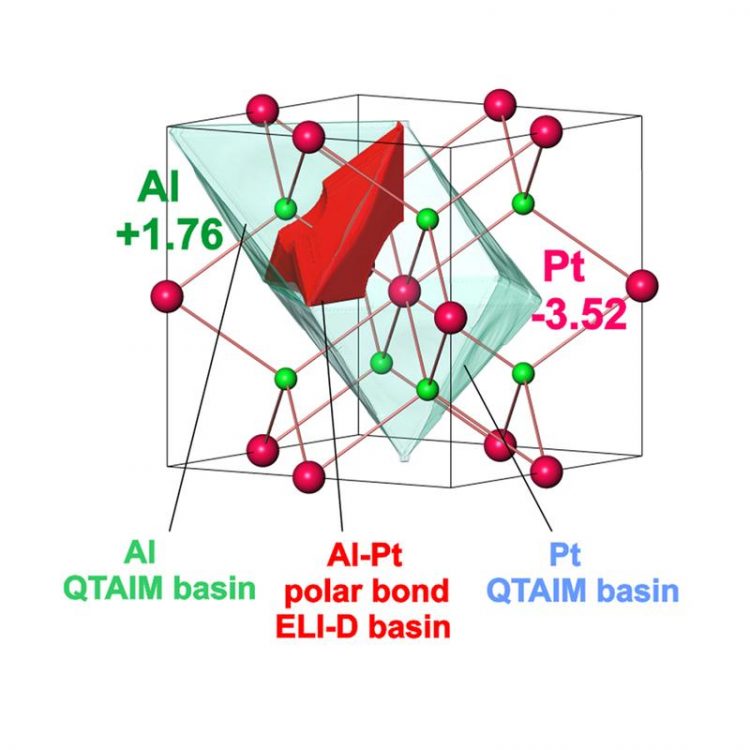Al2Pt for oxygen evolution reaction in water splitting: a strategy for creating multi-functionality in electrocatalysis

Atomic QTAIM basins of platinum and aluminium (transparent) and Al-Pt bond basin (red) in the Al2Pt compound, revealing the pronounced charge transfer from Al to Pt atoms and polar character of Al-Pt atomic interactions. © MPI CPfS
The transition from fossil fuels to renewable energy sources strongly depends on an availability of effective systems for energy conversion and storage.
Considering hydrogen as a carrier molecule, proton exchange membrane electrolysis offers numerous advantages, like operation at high current densities, low gas crossover, compact system design etc.
However, its wide implementation is hindered by slow kinetics of oxygen evolution reaction (OER), enhancement of which requires the application of low-abundant and expensive Ir-based electrocatalysts.
Looking for rational design of new types of OER electrocatalysts and addressing fundamental questions about the key reactions in energy conversion, the inter-institutional MPG-consortium MAXNET Energy integrated the scientists from different institutions in Germany and abroad.
As a result of close and fruitful collaboration within this framework, the scientists from Chemical Metal Science department at MPI CPfS together with experts from Fritz Haber Institute in Berlin and MPI CEC in Mülheim an der Ruhr, developed a new concept for producing multifunctionality in electrocatalysis and successfully illustrated it with an example of intermetallic compound Al2Pt as precursor for OER electrocatalyst material.
Intermetallic compound Al2Pt (anti-CaF2 type of crystal structure) combines two characteristics important for electrocatalytic performance: (i) reduced density of states at the Fermi level of Pt, and (ii) pronounced charge transfer from aluminium towards platinum, leading to strongly polar chemical bonding in this compound (Figure 1). These features provide inherent OER activity (Figure 2) and increasing stability against complete oxidation under harsh oxidative conditions of OER.
Upon OER conditions, Al2Pt undergoes restructuring in the near-surface region as a result of the self-controlled dissolution of aluminium (inset of Figure 2). The roughness and porosity of in situ-formed near-surface microstructure allow to compensate the specific activity loss. Even after exceptionally long stability experiment (19 days) at high current densities (90 mA cm-2) the bulk material retains its structural and compositional integrity.
Extending the choice of synthesis techniques, e.g. thin films growth, and exploring the variety of intermetallic compounds draw the main guidelines for future development of the proposed strategy.
The research at the Max Planck Institute for Chemical Physics of Solids (MPI CPfS) in Dresden aims to discover and understand new materials with unusual properties.
In close cooperation, chemists and physicists (including chemists working on synthesis, experimentalists and theoreticians) use the most modern tools and methods to examine how the chemical composition and arrangement of atoms, as well as external forces, affect the magnetic, electronic and chemical properties of the compounds.
New quantum materials, physical phenomena and materials for energy conversion are the result of this interdisciplinary collaboration.
The MPI CPfS (www.cpfs.mpg.de) is part of the Max Planck Society and was founded in 1995 in Dresden. It consists of around 280 employees, of which about 180 are scientists, including 70 doctoral students.
Iryna Antonyshyn, Yuri Grin
Iryna Antonyshyn, Ana M. Barrios Jiménez, Olga Sichevych, Ulrich Burkhardt, Igor Veremchuk, Marcus Schmidt, Alim Ormeci, Ioannis Spanos, Andrey Tarasov, Detre Teschner, Gerardo Algara-Siller, Robert Schlögl, Yuri Grin, Al2Pt for oxygen evolution reaction in water splitting: a strategy for creating multi-functionality in electrocatalysis, Angew. Chem. Int. Ed., accepted,
DOI: 10.1002/anie.202005445.
Media Contact
All latest news from the category: Life Sciences and Chemistry
Articles and reports from the Life Sciences and chemistry area deal with applied and basic research into modern biology, chemistry and human medicine.
Valuable information can be found on a range of life sciences fields including bacteriology, biochemistry, bionics, bioinformatics, biophysics, biotechnology, genetics, geobotany, human biology, marine biology, microbiology, molecular biology, cellular biology, zoology, bioinorganic chemistry, microchemistry and environmental chemistry.
Newest articles

First-of-its-kind study uses remote sensing to monitor plastic debris in rivers and lakes
Remote sensing creates a cost-effective solution to monitoring plastic pollution. A first-of-its-kind study from researchers at the University of Minnesota Twin Cities shows how remote sensing can help monitor and…

Laser-based artificial neuron mimics nerve cell functions at lightning speed
With a processing speed a billion times faster than nature, chip-based laser neuron could help advance AI tasks such as pattern recognition and sequence prediction. Researchers have developed a laser-based…

Optimising the processing of plastic waste
Just one look in the yellow bin reveals a colourful jumble of different types of plastic. However, the purer and more uniform plastic waste is, the easier it is to…



